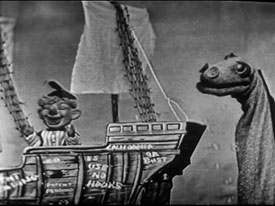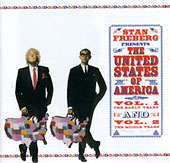 There are comedians who make us laugh out loud with their jokes and hilarious impersonations. There are humorists who make us smile with their insights into the silliness and oddities of the human condition. And then there is Stan Freberg.
There are comedians who make us laugh out loud with their jokes and hilarious impersonations. There are humorists who make us smile with their insights into the silliness and oddities of the human condition. And then there is Stan Freberg.
Stan Freberg has been making me laugh for over five decades. But, most of the time, I don’t know he’s there. That’s because Freberg took his comic genius and did something really useful with it. He went into advertising. Of Stan Freberg, it can accurately be said, “We laughed all the way to his bank.”
TIME FOR BEANY
In 1949, at the age of 23, with several years of radio experience behind him, as well as a four-year stint with Warner Brothers, doing cartoon voices alongside the legendary Mel Blanc — his first full-time job, which he got by walking off the bus and in a second floor Hollywood talent agent’s door, literally — Freberg joined a cast of puppeteers on a local TV station, KTLA.
 The show, “Time for Beany,” became an instant success. It was broadcast live in Los Angeles and southern California, and was soon broadcast across the nation, beginning in 1950. The technology that made this possible was called Kinescope [KINNess-scope], and it is why we can still watch videotapes of “The Honeymooners.”
The show, “Time for Beany,” became an instant success. It was broadcast live in Los Angeles and southern California, and was soon broadcast across the nation, beginning in 1950. The technology that made this possible was called Kinescope [KINNess-scope], and it is why we can still watch videotapes of “The Honeymooners.”
The show won three Emmy’s during its six-year run. During its heyday in the early 1950’s, it sometimes had 60% of a local city’s viewing audience in its 6:30—6:45 evening time slot, five nights a week. The show was the creation of puppeteer Bob Clampett, who had created the Tweetie Bird character during his years at Warner Brothers.
It was the only kids’ show in my era that was watched faithfully by our parents. The whole family watched. Albert Einstein was a big fan, as were Jimmy Stewart and Groucho Marx. It featured Beany Boy, Captain Huffenpuff, Dishonest John, and Cecil, the Seasick Sea Serpent. Freberg did the voices for the latter two. The characters all sailed the seven seas on the Leakin’ Lena. It was through “Time for Beany” that I first learned the crucial distinction between “funny, ha ha” and “funny, peculiar.”
Freberg in his 1988 autobiography, It Only Hurts When I Laugh, says that in the show’s early months, they rehearsed the next evening’s show in a parked car. Not the same car — any car with unlocked doors. They later moved their offices to “This Building Condemned.” The phrase “low budget” comes to mind.
RECORDS (VINYL)
In 1950, Freberg created a genre which only he ever fully mastered: the “take-off” record. It was a spoof, usually of other popular records or TV shows.
The initial breakthrough was “John and Marsha.” It was a spoof of radio soap operas. Freberg did two voices, a man and a woman. John said only “Marsha,” and Marsha said only “John.” The voices ran the full gamut of soap opera emotion. The record was very funny, a big hit, and cured me forever of soap operas.
Over the next decade, he followed with two dozen more take-offs, including one of Lawrence Welk, “Wunnerful, Wunnerful,” a 2-side record: side uh-one and side uh-two. Word got out that Welk didn’t understand why the record was so funny. This, I can believe. He was about as funny as Ed Sullivan, whose lawyers kept Freberg’s take-off on Sullivan from ever being released. Freberg’s biggest hit was a spoof of the “Dragnet” TV series, titled “St. George and the Dragonet.”
 Then, in 1961, came his masterpiece, “Stan Freberg Presents the United States of America, Part 1.” I was majoring in history, and I found it brilliant. I still think so. It was a 40-minute musical comedy of the years from Christopher Columbus to the end of the American Revolution. In my view, it remains the most creative comedy skit ever recorded. It included some lively, memorable songs, such as “Take an Indian to Lunch” (Thanksgiving) and “(Put on Your) Top Hat, White Feather, and Tails” (the purchase of New York City).
Then, in 1961, came his masterpiece, “Stan Freberg Presents the United States of America, Part 1.” I was majoring in history, and I found it brilliant. I still think so. It was a 40-minute musical comedy of the years from Christopher Columbus to the end of the American Revolution. In my view, it remains the most creative comedy skit ever recorded. It included some lively, memorable songs, such as “Take an Indian to Lunch” (Thanksgiving) and “(Put on Your) Top Hat, White Feather, and Tails” (the purchase of New York City).
Then there is Ben Franklin’s forgotten meeting with Tom Jefferson, who presents Franklin with a copy of his newly written “Declaration of Independence” for Franklin to sign. As we all know, Franklin’s name does not appear on the document. Freberg offered this explanation. Jefferson desperately wants Franklin to sign. Franklin goes over it verbally. “When in the course of human events . . . da, da, da . . . da, da, da . . . Life, liberty and the Purfuit of Happineff.” He asks aloud: “Purfuit of happineff?” Tom assures him that the f’s are “in, very in.” But Franklin still hesitates. “Then he breaks into a chorus of “A Man Can’t Be Too Careful What He Signs These Days.” This includes the line, “It looks a little pink-o to me.”
 His records were a big hit in Australia, even “St. George.” This was before “Dragnet” was on Australian TV. He was invited to run the final leg of the torch in the 1956 Olympic Games. An enormous honor! At the end of the run into the stadium, he staged it so that he was met by a man with an unlit cigar. The man leaned over for a light. Sure enough, Freberg used the sacred torch to light the guy’s cigar. The fans might have been outraged, but instead they clapped and stomped their feet — and not on him. As David Gordon might say, Freberg experienced the thrill of victory, not the agony of the feet.
His records were a big hit in Australia, even “St. George.” This was before “Dragnet” was on Australian TV. He was invited to run the final leg of the torch in the 1956 Olympic Games. An enormous honor! At the end of the run into the stadium, he staged it so that he was met by a man with an unlit cigar. The man leaned over for a light. Sure enough, Freberg used the sacred torch to light the guy’s cigar. The fans might have been outraged, but instead they clapped and stomped their feet — and not on him. As David Gordon might say, Freberg experienced the thrill of victory, not the agony of the feet.
ADS
In 1956, he took the first step toward a new career: advertising. He was asked to do an ad for a tiny, struggling company with a limited-demand product: tomato paste. Hunts Foods dominated this market. His job was to build market share for Contadina.
So, he came up with a jingle: “Who Puts Eight Great Tomatoes in That Little Bitty Can?” There was nothing about free recipes or how thick the paste was. Just the jingle. He sang it himself, with the Buddy Cole jazz trio backing him up. The company’s flacks hated it. The ad brokers hated it. Only the president of the company liked it. He thought it was funny. He paid to run it. It was a smash hit. Disk jockeys kept commenting on it after it ran. Market share skyrocketed. Hunts had to cut prices for its tomato paste.
 Freberg had violated the crucial law of all direct-response advertising: “Clever doesn’t sell. Benefits sell.” Humor is part of clever — in fact, the most dangerous form of clever. For the next 47 years (so far), Freberg violated the rule. Yet he says he has never produced a market-losing campaign.
Freberg had violated the crucial law of all direct-response advertising: “Clever doesn’t sell. Benefits sell.” Humor is part of clever — in fact, the most dangerous form of clever. For the next 47 years (so far), Freberg violated the rule. Yet he says he has never produced a market-losing campaign.
I make my money writing ads. Even my Lew Rockwell.com articles are ads. (See the subscription sign-up links below.) I can speak with the authority of a man who has put his own money on the line: clever doesn’t sell. Usually.
But occasionally it does. For example, Volkswagen’s magazine ads of the early 1960’s, “Think Small” (a tiny photo of a VW in a full-page ad) and VW’s all-time rule-breaker, “Relieves gas pains.” Doyle Dane Bernbach got famous with those ads. (What is rarely mentioned is that those ads featured photographs — a no-no in automobile advertising before then. The ad industry learned late that carefully crafted photos — the illusion of realism — almost always out-pull drawings.)
Clara Peller’s “Where’s the beef?” rocketed Wendy’s sales in 1983. But the all-time winner was Wendy’s owner, Dave Thomas, whose TV ads sold billions of dollars of food, and ceased only with his death. He was so nice, and he always offered the viewer a benefit for coming to eat at his restaurants. Dave was not clever.
In my humble opinion, the funniest TV ad of all time was Alka-Seltzer’s 1973 “Momma, Mia, that’s a spicy meatball.” I would watch it over and over and still laugh. That was Roy Grace’s work, the DDB adman who had also worked on the “Think Small” campaign. But the ad lost market share for Alka-Seltzer. Surveys taken later indicated that the public remembered it as an ad for spaghetti sauce. Similarly, Isuzu’s “Joe Isuzu” ads — “he’s lying” — made comedian David Leisure’s face famous, but the ads did not raise the sales of Isuzu.
 Freberg simply refuses to acknowledge that clever doesn’t sell. He created ads for a canned Chinese food company owned by an Italian. He made the owner even more of a multimillionaire. Here is an example: a full-page magazine ad with this announcement, “Nine out of ten doctors recommend Chung King chou mein.” This appears beneath a photo of ten men in white smocks, each wearing a stethoscope. Up front is one middle-aged white guy. The rest are Chinese. I laugh just thinking about that ad. It ran forty years ago.
Freberg simply refuses to acknowledge that clever doesn’t sell. He created ads for a canned Chinese food company owned by an Italian. He made the owner even more of a multimillionaire. Here is an example: a full-page magazine ad with this announcement, “Nine out of ten doctors recommend Chung King chou mein.” This appears beneath a photo of ten men in white smocks, each wearing a stethoscope. Up front is one middle-aged white guy. The rest are Chinese. I laugh just thinking about that ad. It ran forty years ago.
Then there was the Great American Soups TV ad for Heinz. It ran in the mid-1970’s. It featured the woman with the greatest legs in Hollywood, Ann Miller, who had danced her way through MGM musicals in the 1940’s. She still looked terrific. She danced on top of a giant soup can in a Busby-Berkeley re-creation.
And the ad for Sunsweet de-pitted prunes:
TODAY THE PITS… TOMORROW THE WRINKLES.
SUNSWEET MARCHES ON!!!
We direct-response ad people insist on copy. Lots of copy. Well, Freberg can write tantalizing copy with the best of them. Us. Whatever.
Well what do you do with a prune pit once it’s in your mouth? Disgusting. There’s no way you can get rid of a prune pit, gracefully. That’s why Sunsweet has developed The Pitted Prune. How do we do that? We do it. Let’s lay our prunes on the table; until now, most people didn’t like prunes very much. As a matter of fact there were people who wouldn’t touch one with a twenty-foot pole. Apparently they didn’t find anything all that appealing about a piece of wrinkled fruit that could knock out a $75.00 inlay. But that’s all behind us now. Shake hands with the Pitted Prune; sweet, moist, although still rather badly wrinkled. One thing at a time, please. Today, the pits . . . tomorrow the wrinkles. SUNSWEET MARCHES ON!!!
Are there benefits in this copy? Yes. Do people worry about crunching down on a prune pit? Yes. Is there a graceful way to get rid of one in polite company? No. All true. So, how do you get the message of deliverance across to readers without being laughed at? You don’t. So, if you are Sunsweet’s owner, you bear the laughter all the way to your bank. A spoonful of laughter makes the pitted prunes go down.
For us ad writers who enjoy a good laugh, but who don’t have the wherewithal to risk being clever — the fear of wherewithout — Stan Freberg is our shining star. For it was he, standing tall, who adopted as his company’s slogan the inspiring words:
Translation: “Art for money’s sake.”
Rhino Records has put together a set of 4 CD’s of Freberg’s humor, and one of them is entirely devoted to his radio commercials. You also get a videotape of his TV commercials. For anyone thinking of going into the advertising business, these commercials are a must. Listen to them. Watch them. Master them. Then avoid trying to imitate them. You will lose your shirt if you try.
Clever doesn’t sell.
A DAY WITH STAN
If you could win some reality TV award, and the prize was spending one day with any celebrity, which celebrity would you choose? What would you spend a day talking about with a celebrity? “I really like your movies.” “Thanks.” “You’ve got a nice place here.” “Thanks.” Then what?
 I would pick Stan Freberg. Nobody else. I would go to his home. Contract or not, he would be missing. “So, sue me.” He is paranoid about his privacy, except when he is pathological.
I would pick Stan Freberg. Nobody else. I would go to his home. Contract or not, he would be missing. “So, sue me.” He is paranoid about his privacy, except when he is pathological.
I would ask if his son Donovan were anywhere around. Donovan was the Encyclopedia Britannica kid, back when the EB cost $1,300 instead of $50 on a CD-ROM. He might be around. Anyway, someone could phone him. He might come over. I’d ask him to show me his father’s ad clipping books. We would go through them, page by page. He would tell me about each one.
Then we’d watch an hour of Kinescopes of “Time for Beany.”
It would be my best day in the last thirty years . . . or the next thirty.
 Gary North is the author of Mises on Money. Visit http://www.freebooks.com. For a free subscription to Gary North’s newsletter on gold, click here.
Gary North is the author of Mises on Money. Visit http://www.freebooks.com. For a free subscription to Gary North’s newsletter on gold, click here.




